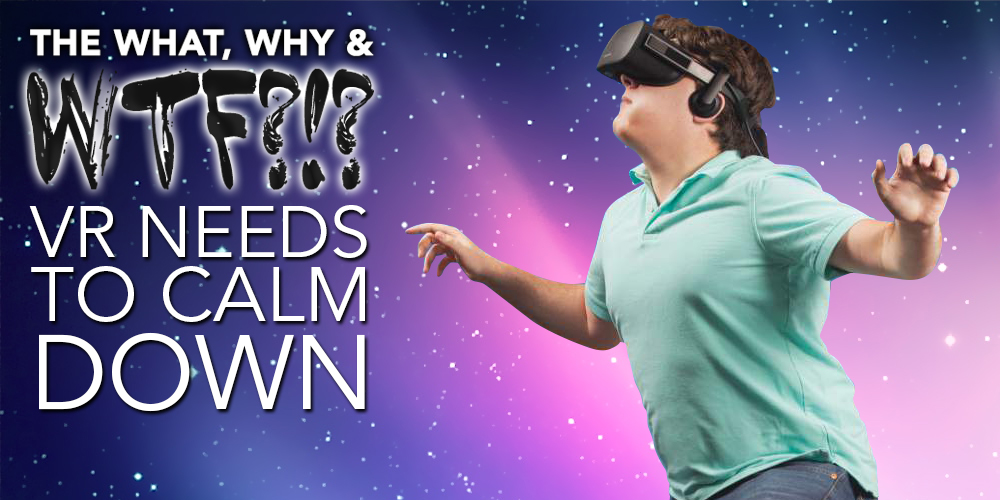
You know when someone really wants you to get up on something, but you don’t really want to get up on it because you can’t spare the time, money or effort to get up on whatever it is, and even though you can’t stop hearing about it, it just doesn’t seem that get uppable, especially when you factor in that nothing up there looks as good as what’s down here, like the act of getting up is just as pointless as being up, but you can see the value of getting up, with the getting and the up of it all, but you really just can’t, because you’re not seeing the gettableness or the uppiness as an unbelievably incredible thing like everyone else who’s trying to get you up on it is? That’s VR.
I’m not sold on VR, but everyone involved in VR seems to think I am. We’ve got the Oculus Rift, the HTC Vive, and now the Playstation VR, but there’re no games that utilise VR in any meaningful way yet. So far, it’s all been games you could play on a monitor as easily (if not easier) as with a headset, or it’s experiences that choose to immerse you in something that isn’t exactly a game. Sure, games like EVE Valkyrie, Elite: Dangerous and ArmA might be cool in VR (and we’re not going into Track IR here), but they don’t give me a compelling reason to use a headset over a monitor. So much hype is surrounding this new technology, and I’m not saying it’s without reason, but these guys need to bring it down a notch and come back to reality. The real one. You know, this one.

… Or stay in VR.
VR is not a new fad, but it is certainly a historical failure. Trying to simulate experiences goes all the way back to the early 1800’s (here’s a great recap!), but as far as gaming is concerned, we only need to go back to 1991. The concept of VR had been poked at throughout the ’80s, but devices like the Nintendo Virtual Boy and Sega VR didn’t quite deliver Tron-level experiences. They were laggy, choppy messes of products, and they didn’t offer up a new reality because the technology just couldn’t provide. Of course, that was then, and technologies like OLED displays and IR LED assisted 6DOF motion tracking have come a long way since not existing.
The hype for VR as we know it started in 2012 when the Oculus Rift Kickstarter campaign was launched. Here was a headset that had ambition and was endorsed by everyone’s favourite Coeus-in-disguise, John Carmack. Just because one legend in the games industry/ex-aerospace engineer backed a project (we’ll ignore Gaben in their campaign video) didn’t mean people wanted to buy it, but this was the first headset that looked like it could pull VR off. It promised minimal lag, explained its mechanics in its campaign, was designed for gaming and wanted to openly involve as many people as possible in its development. Oculus was, funnily enough, lapped up by thousands of enthusiasts, and VR started becoming something more than an underground movement.
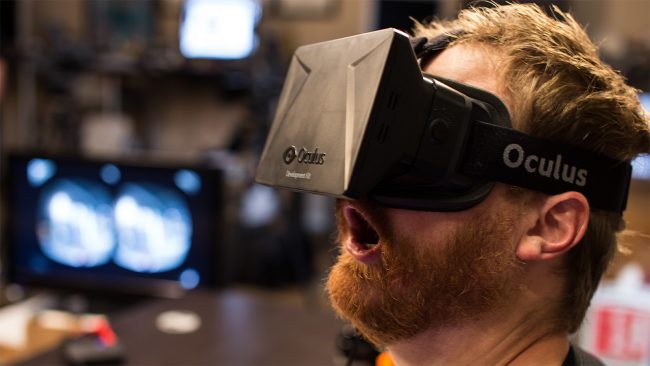
And so, VR Face was born.
The key thing to remember here is that the Oculus wanted to deliver a product that the general consumer could buy, and others started taking note. Seeing an opportunity to cash in on the newest trend, bigger companies like Google (it’s always bloody Google, isn’t it?) started releasing their takes on VR. The key was mass appeal, so while dedicated headsets were being developed, devices like the Samsung VR and Google Cardboard (which suck, btw) focused on re-appropriating existing phone gyroscope/accelerometer technology for VR. Regardless, we’re seeing stuff like the Playstation VR and HTC Vive rearing up to sell themselves to the more hardcore audience alongside the Oculus, and I’m not sold.
The technology may have advanced to an acceptably cool level, but there are new reasons to be skeptical. For a start, running VR takes a PC with more grunt than your wallet can muster, with the minimum price I could find for a minimum-spec card (a GTX 980) being ~$450. The cost comes with the territory, I suppose, but there aren’t even any games in VR that I’m interested in. At best, we have the likes of Asetto Corsa, EVE Valkyrie or Subnautica, but I can just as easily play these on my monitor for a fraction of the price without the nausea. That’s not the point, though, is it? Don’t worry; I get that the potential for an incredible level of immersion is there, but let’s take a step back and try to cut through the hype a bit, shall we?
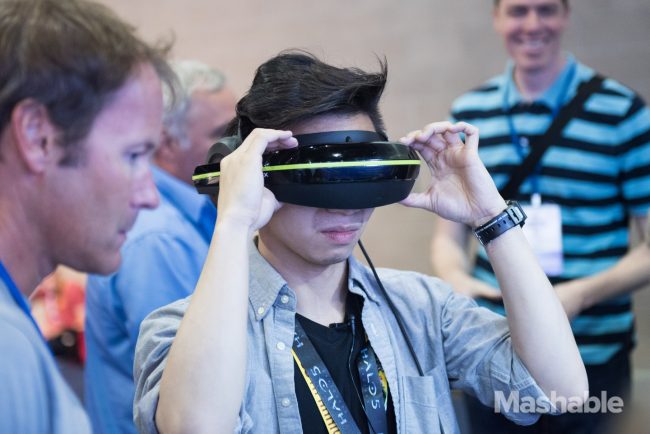
This guy from Mashable has the right attitude.
People are hard-wired to be overoptimistic. In essence, we tend to think that bad things are less likely happen less to us than other people, and it’s tough to make people think otherwise. It could be as simple as thinking you’re likely to get a job or thinking that the new Fallout will be flawless. In the case of going for that job, this bias can be quite useful, making us more confident in the face an intimidating scenario. In the case of games, it leads us to make really, really, really dumb choices about pre-orders and Kickstarter backing. This inherent bias also cranks up our other biases, such as our delusion that things are better than they are.
Let’s go back in time again, but not to look at the Virtual Boy, oh no, we’re going to get hype for the new Star Wars! It’s common knowledge that Episode 1 was an absolute disaster, but when the reviews started coming out, it wasn’t all bad. Some critics (Roger Ebert being the most notable one) gave the film positive reviews, most likely because these guys wanted the film to be good… So it was. They went in hoping for a great movie, and they got it, and much the same can be said about VR. If you’re willing to delude yourself into thinking something will be good, well, you’ll think it’s good, and this is leaking into a lot of developers heads.
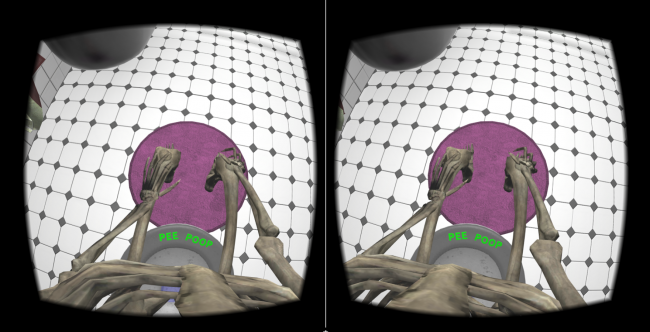
I shit you not, Toilet Simulator is real. And it’s rating remarkably well!
Let’s look at some games coming out for VR in the future. Let’s take, oh, Hot Dogs, Horseshoes and Hand Grenades. It’s impressive, for sure, with some insanely realistic modelling on the M4, but it’s a tech demo. It’s a glorified $20 sandbox tech demo, and it doesn’t make me want to go out and buy a Vive or a Rift, but this is the precedent being set. This game is, of course, not a very gamey example, so how about Final Approach? $25 for a bunch of mini games that look like they’re more suited to a mobile device? Yeah, sure, that’ll sway me as much as an anvil (bad example, because I’d like an anvil at some point). It’s fine to take pride in your work and think positively about it, but this is setting the standard, and it’s not great. The fact that developers are releasing these games implies that they think this is acceptable to charge for, and perhaps more grandly, the future of gaming.
Perhaps the most dangerous part of all this hype is that it’s feeding into itself. I’ve talked about self-fulfilling prophecies before, and VR is becoming to gaming what Djent is to metal. Djent, for the unaware, is a style of metal that focuses on rhythmic variation, groove and low tuning, with roots in more genres than you can name. It started off as (and still is) something people said, arbitrarily labelling songs as Djent, and it eventually turned into a genre of its own. VR is touting itself as the future of gaming, and the more people it lures in, the more it cements the idea that, yes, it will become the Djent of gaming. The problem is that the future is now, and while it seems that developers have convinced themselves of VR’s worth, I’m wholly unconvinced.
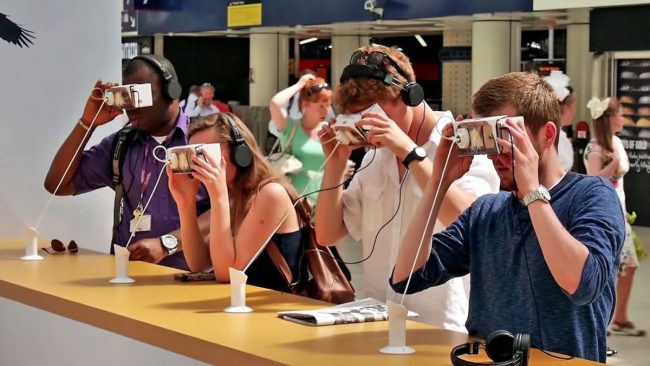
Pictured: A distinct lack of enthusiasm regarding this new and exciting tech.
So, you might be reading this and thinking nothing will convince me that VR is worthwhile. Of course it is, I LOVE the idea of VR, but I have serious reservations about its potential. Not seeing your keyboard/preferred input or where you are in physical space, superfluousness in games, the lack of haptics, these are all very real and significant problems in my eyes. The other major problem is that no one is talking about VR’s counterpoint: AR.
Augmented Reality (yes, that AR) is exactly what it sounds like. Instead of putting a headset on and blocking out reality, AR augments what we see to create a pseudo-reality superimposed onto our own. Think Microsoft Hololens or Google Glass (it’s always bloody Google), where images and sounds are still being supplied to you, but they’re not taking over your senses to block out real life. Blocking out your senses is also why you get nauseous, in a way that’s like the inverse of seasickness, so not depriving you from the real world eliminates that problem. Don’t get me wrong; AR isn’t even remotely close to being on par with what VR is currently doing, but if it gets worked on, it could be amazing.
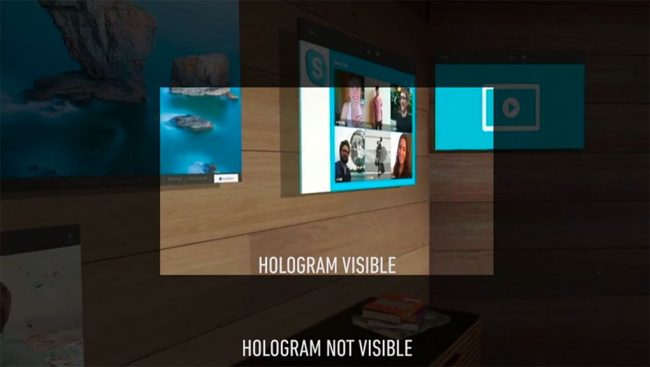
Just keep in mind that AR is looking pretty disappointing too, right now.
… Which is what we could say about VR, right? Well, no. What you’re seeing happen with VR is what VR is, and that’s it. Unless we start sending small shocks to make particular muscles twitch (alarm bells should be ringing in your head), VR isn’t going to evolve far beyond what it is right now. AR, however, assumes that the user is already a physical being with a physical presence, and as such, games could play off of this. Now, instead of having procedurally generated environments, you just use the environment on offer with randomly spawning enemies. On top of that, you don’t need to go through an arduous set up to play a game; you could even just have an AR screen to play your regular games. Again, this isn’t going to happen anytime soon, but it’s more appealing due to the inherent strengths of the device.
But why stop there? As technology continues advancing, there will come a point where AR and VR devices will be the same thing. The sooner people key into this, the better. Forgive my overoptimistic hypocrisy, but if we could have VR headsets that could switch to an AR setting by folding the front or using smart glass, then one of the hurdles of VR will be immediately solved. Hell, let’s keep going! VR/AR capable games, designed to switch out of AR and VR depending on the situation or on what menu you’re in! Frickin’ sweet! Neither of these solves the problems of haptics or crappy games, though, so let’s bring it down a notch.
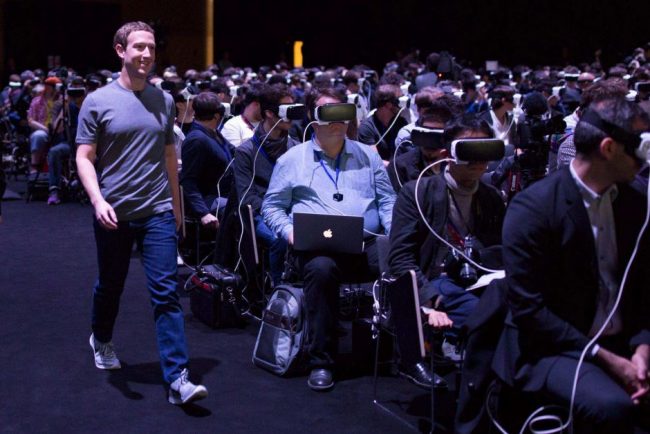
The only person smiling in this photo is Mark Zuckerberg, who isn’t wearing a headset.
… And is a billionaire.
I see the potential of VR/AR, but if there aren’t games where the headset plays a significant and meaningful role in gameplay, it will forever remain a gimmick. At the core of the Oculus Rift’s development was a focus on games, but nothing has delivered any compelling reason to buy a Rift. There’s no advantage to having a VR headset, competitively or mechanically, over using a monitor, but it’s not just because no one’s been developing. There are plenty of games that are VR capable, but nothing has lived up to expectations, and unless something comes along that utilises the technology beyond “putting yourself in the game”, I’m good with a monitor.
VR is undoubtedly an appealing concept, being able to immerse yourself in the game world unlike ever before. Unfortunately, developers seem to have sold the idea of how willing consumers are to take VR on at face value without considering the relevance of their own game. Instead of seeing games that make use of the ability to look around, we’re only seeing games that promote but not reward these actions. Without good games that use the technology in a meaningful way, the technology isn’t appealing to me, especially when you consider the cost, set up and headaches. So, yeah, VR devs. You guys need to calm down. Just because you’re using VR doesn’t make you interesting; your game is what needs to get me hype for VR.











